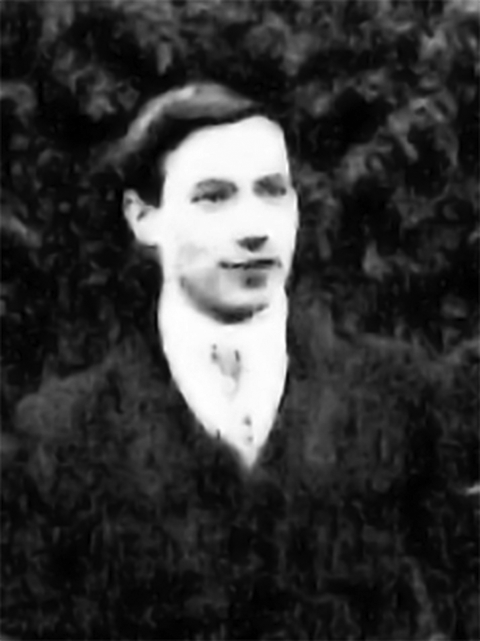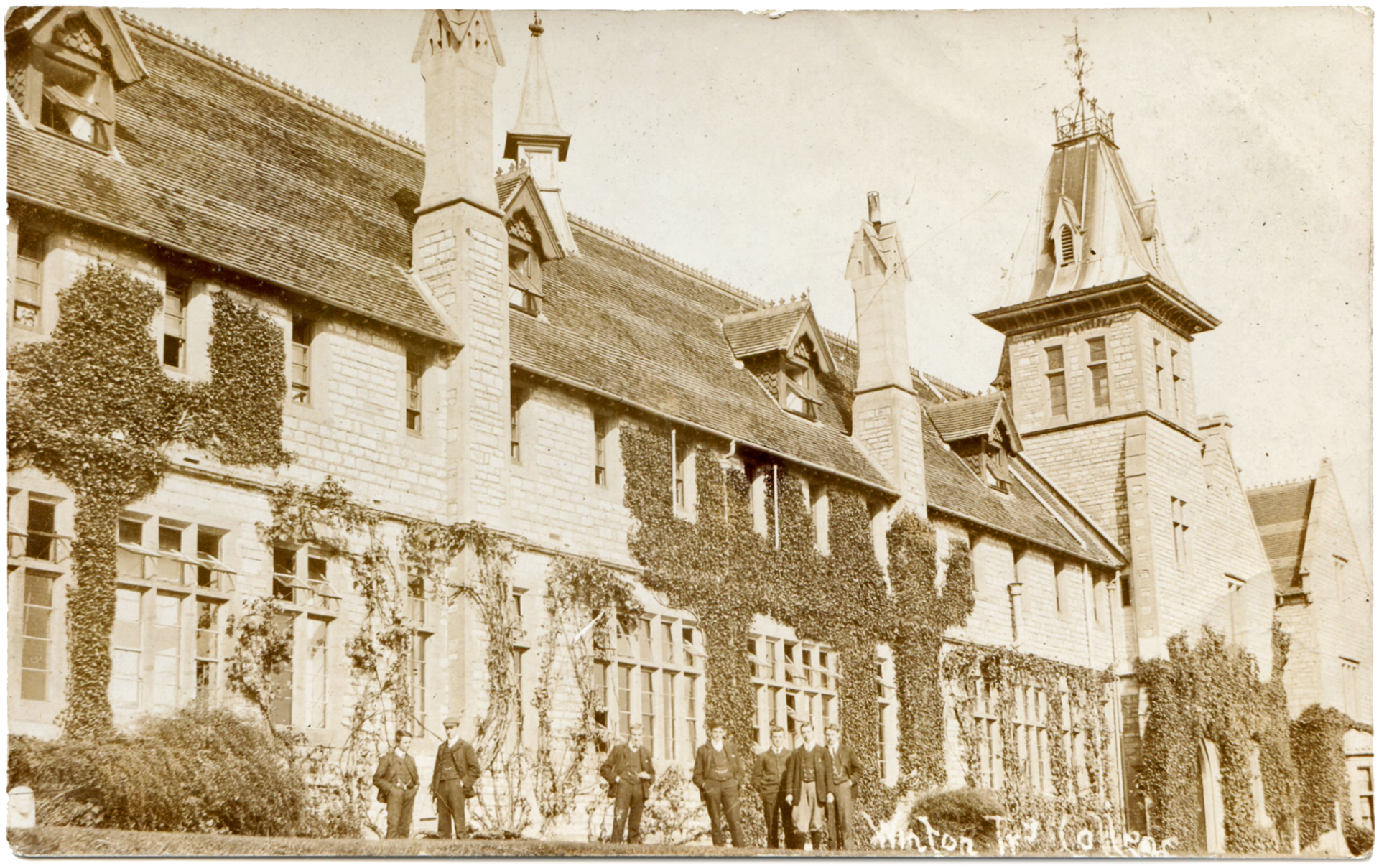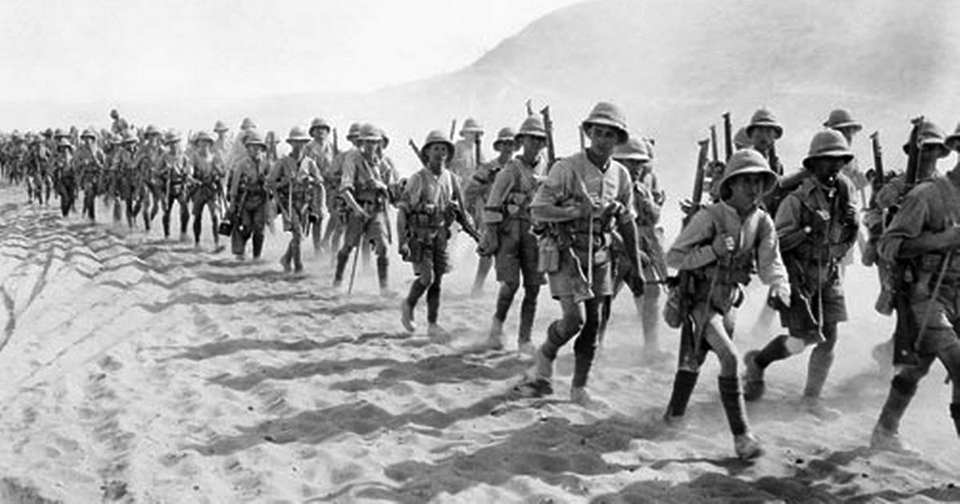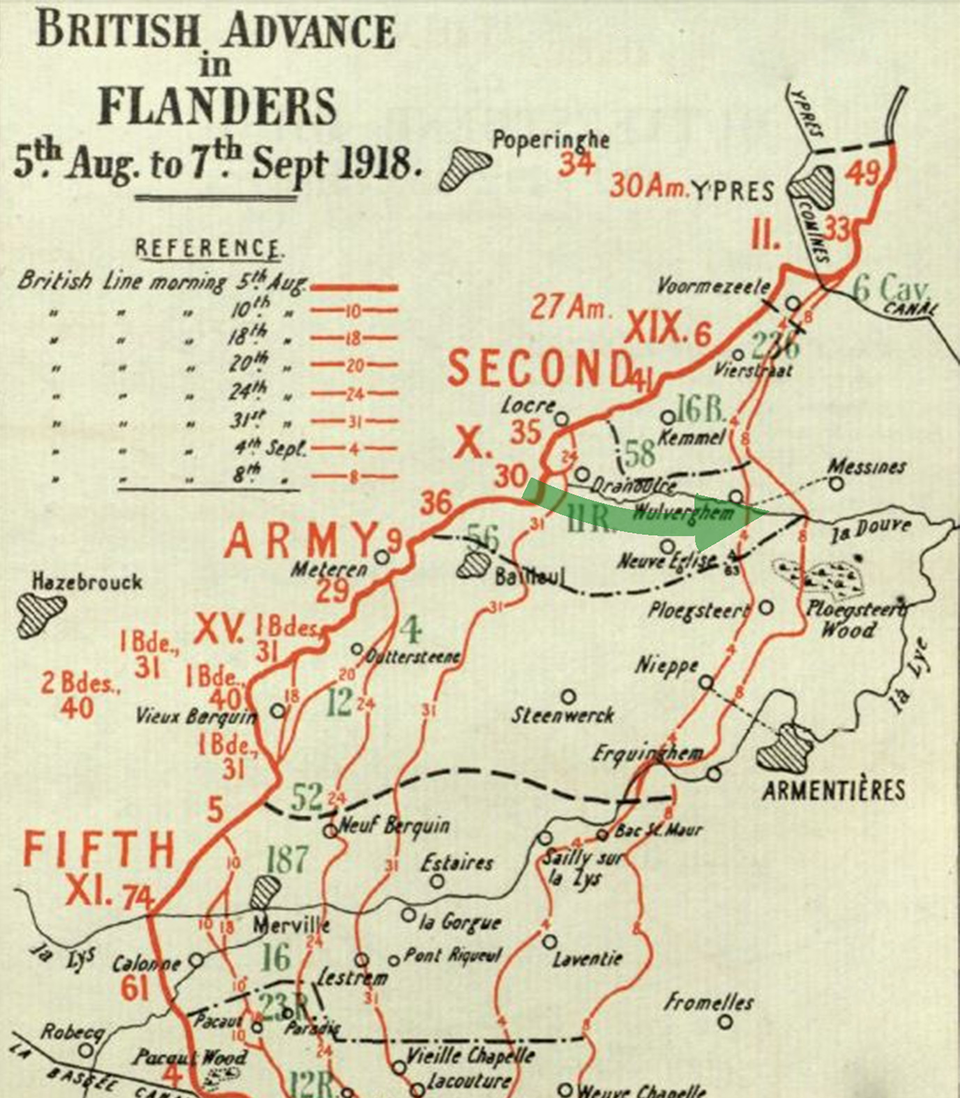Lieutenant Percival Samuel Henry Grice, of London Regiment, 2nd/17th (County of London) Battalion, (Poplar & Stepney Rifles), was killed in action on the Western Front on 2nd September 1918.
Home Life

Percy’s father was born either late 1860 or early 1861 in Poplar, London (then Middlesex). Although we do not have an exact date of birth, his given names were Samuel Christmas; we can reasonably surmise that he was born on 25th December, 1860.1 Unusual middle-names can often be received indifferently by a child, but we know that he liked his as sometimes he chooses to be called by it.2 He was known by both names—we shall refer to him as Samuel, the name he chose to pass on to his son.
Samuel’s parents were Norfolk-born and his father, John Henry,3 worked as a House Carpenter and, later, builder who had settled to trade in the Tower Hamlets area of London. Samuel was to beat a different career path that would, in time, be followed by Percy4—but more of this later.
As befits someone with the name Christmas, Samuel married Percy’s mother on Boxing Day, 1888, at St Dunstan and All Saints Church, Stepney. His bride, Margaret Stewart Wilson,5 was born in 1866 in neighbouring Aldgate. At the time of the wedding, they were both living in Stepney but the new couple were to settle to married life in a 1-bedroom flat6 at 68 Brunswick Road, Leyton. Percy was added to the family on 16th October, 1890, and Lilian followed on 3rd December, 1892. They were born in Limehouse and Bethnal Green respectively.
Percy attended Malmesbury Road School, Bow, passing through the Infant and Junior departments. Lily is also to be found on the Admissions Register of the school. The family’s address at that time was 33 Lawrence Road, which adjoined Malmesbury Road.
The school was large: the register for the 1899 calendar year shows that 4737 pupils entered the school in the twelve-month period. Literacy levels were low: of the 54 pupils (aged 7 to 13) admitted at the start of the school year and who had not been to Malmesbury Road Infants School, 22 could not read.8
On completion of his elementary education, Percy was employed as a pupil teacher. The usual practice was for the child to continue at the school where they had been taught, but Percy’s appointment was at Upton Lane Boys’ School 2½ miles to the northeast, in Forest Gate.
Although pupil teachers were restricted by law to 20 hours classroom work per week, life could be hectic. Headteachers were charged with the responsibility of tutoring the trainee before and after the school day, and most pupil teachers would attend pupil teacher centres for further training, both during non-classroom days and at evening classes. Percy passed a course in Physical Training at a pupil teacher centre. He also passed Physics and Chemistry (theoretical and practical); the centres were one of the few places that had laboratory facilities to teach such courses.
The major qualification awarded to him was his Cambridge Senior Local examination, achieved with a distinction in Geography. This was recognised as a college entrance standard of education and enabled him to apply for a place at a teacher training college. He chose Winchester. For further details on teacher training, there is a feature article here.
Training (1909–1911) and Teaching
In 1881 we find that Percy’s path to Winchester is one that had been trodden before—by his father. In the Census of 1881, we find that Samuel was among the fifty-four students of Winchester Training College,9 training to be a teacher under the Principal Rev. Henry Martin.
Henry Martin’s tenure at the College had begun three years before Samuel’s admission and would last until the year after Percy’s leaving. After training, Samuel had returned to Tower Hamlets to teach there until his early death in 1909, aged 49 and only a matter of months before Percy began his studies there. It is sad to reflect on how much Samuel would have looked forward to hearing Percy’s experiences of his first term, and the excitement of comparing notes, recalling old haunts and reliving bygone student days and stories, in their conversations together.

The College student publication, The Wintonian, gives us the only direct reference to Percy: he was a member of the Corinthians football team in an in-house yearly football competition where all students were able to take part in a sporting challenge regardless of their ability. It was rather underwhelmingly reported that ‘Bridgeland and Grice have helped us when required.’
His official Student Record shows that he had a spread of abilities, tending to indicate strengths in the arts. Of those subjects for which there are grades, we see that he achieved: Music, B; Drawing, A; Science, C; Teaching, D; and Reading and Recitation C.
On leaving, Percy is recorded as going to teach at ‘County School, Abbey Road, West Ham’.10 More commonly known as Abbey Road Board School, it was opened in 1881 with places for 900. A wing was added in 1885, and by 1893, after further extensions, there was accommodation for 1,660.11

We can gain an appreciation of how difficult a post in this school would have been. One of the female teachers at the school, Grace Dexter, left a subsequently published diary.12 She helps us understand the challenges that would face Percy in his teaching at this inner-city school of over one hundred years ago, albeit from her experiences a few years before Percy’s time.
Grace’s family was from the East Midlands and she grew up in an evangelical Baptist environment that had a strong emphasis on social action. Grace particularly was involved in the mission work for the poor. On September 15th, 1891 she writes of her greatest desire as being ‘the work which I have always thought to be right—that of helping those who are poor and suffering.’ She was well used to teaching waifs in Nottinghamshire and Derbyshire but her desire was to teach in London, where she sensed there was deep social need. Dr. R. Edlin-White, editor of Grace’s Diary, adds, from Grace’s unpublished reminiscences, details of a prior visit to London: ‘One thing that Grace was exposed to whilst in London was the immense disparity in the lives that the well-off and the very poor lived. Whilst Grace was in London there was a very heavy snowfall. The snow fell that thickly that ordinary life was severely affected; the very poor found it all but impossible to scrape a subsistent living. Food shortages followed and then the poor began to riot against the conditions that they found themselves forced to bear. Grace, being a devout Christian, was much affected by the plight of the poor and was keen to do something to alleviate their suffering.’13
Helped and guided by a longstanding friendship with Florence Nightingale, she eventually took a teaching post at Abbey Road School. Her diary reads, ‘October 10th, 1892 Monday morning started at the Abbey Road Schools,14 West Ham. They are the second largest in the United Kingdom… Well, the Mistress is very nice, so are the teachers as far as I know. I teach the VI & VII Stds. the highest in the school.’
Percy, had been brought up and lived, with the exception of his two years at Winchester, all of his life in Tower Hamlets, and learned from his father what it was like to teach there. He would have known exactly what to expect in the new job and committed to this difficult teaching environment with his eyes wide open. Presumably he also had the personal fortitude, skills and resources to succeed.
At War
Percy began his war service, on 17th November 1915, joining the 2/17th Battalion, London Regiment (2nd Poplar and Stepney Rifles) at their Battalion HQ at 66 Tredegar Road, Bow, with the Regimental Number 5324. His Medical Inspection Report tells us that he was 6ft 1in tall, had perfect eyesight, good physical development and a chest measurement of 36½in. On entering Service he also signed the Imperial and General Service Obligation form which meant the Army could post him overseas.
Also known as the 2nd Poplar and Stepney Rifles, the Battalion was raised in London in August 1914. The Battalion had been in training at Bishops Stortford since May 1915 and they moved to Sutton Veny, Wiltshire in January 1916 for final training.
He was able to get home leave from his unit and, on 24th February, 1916, Percy married his fiancée, Florence Gertrude Morgan at St. Stephen’s Church, Bow. Florence was also a London County Council Teacher. As often the case with wartime weddings, the arrangements would have been rushed as it was impossible to know in advance when Army leave would be granted. There being no time for the reading of banns, they were married by Common Licence.15 This was sought by Percy at 1 Dean’s Court, Doctor’s Commons—the Diocese of London’s office—the day before the wedding. Florence was from a large Cockney (i.e. Bow, London) family. Born there on 8th April, 1886, she was the youngest of 10 children: 3 boys and 7 girls.16
Florence Gertrude’s sister, Maud Lillian Jerrett herself also served in the War effort. In civilian life, she was Forewoman in the Outdoor Yard at a cardboard box factory, from which she joined the Women’s Army Auxiliary Corps17 as a ‘Quarters Forewoman’. In 1920 she was awarded The Medal of the Order of the British Empire,18 19 for her War service.
Florence and Percy would have only one night together as man and wife: on 25th February 1916 Percy began Officer’s Training at Denham Cadet Unit, Buckinghamshire. He would be there until 8th July. On July 14th he was appointed to a Commission, again in the 17th Battalion London Regiment.

In the meanwhile, the Battalion had moved to France on the 23rd of June, landing at Le Havre. 2nd Lieutenant P.S.H. Grice joined his unit on the Western Front. Initially his Commission was made on probation and the rank was confirmed on 1st December. The 2/17th Battalion was not to stay on the Western Front for long. After a short time at the Battle of the Somme, in November 1916 they were ordered to Salonika (Thessaloniki, Greece). Travelling by train from Longpré to Marseilles and sailing via Malta, they arrived in Salonika on Christmas Day, 1916.
In April and May 1917 they were in action during the bloody failure at the Battles of Doiran. This action was part of the Macedonian Front and its aim was to defeat the Bulgarian army and effect a wide breakthrough in the Balkans. Out of 45,000 British troops, over 12,000 were either killed, wounded or captured. Further promotion came on 17th May, 1918, when Percy was made up to Lieutenant.

Percy’s Battalion was withdrawn from Macedonia and moved to Egypt, concentrating at Moascar, near Ismailia, in the Southern Suez Canal Zone, before being sent north into Palestine. The plan there was to push the Ottoman forces north, and this was to prove an altogether more fruitful campaign. Percy and his men then entered a hugely successful but frenetic series of engagements. In rapid succession, they were in action in the capture of Beersheba (31st October, 1917) and immediately following, the Third Battle of Gaza on the 1st and 2nd of November. They moved on to the Battle and Capture of the Sheria position (6th-7th November), the Battle and Capture of Jerusalem (17th November to 30th December), and its subsequent defence.
There is an overview of the Egyptian and Palestinian Campaign in a feature article here. One strange coincidence in this period is that Percy’s battalion was posted to the newly captured hilltop shrine of Nabi Samwil (spellings vary) on November 25th, the day after fellow Wintonian Reginald Fulford had died there. It is not known if the two men were aware of each other’s presence in the same arena or if Percy knew of Reginald‘s death.
The pace would not ease with the coming of the New Year: from the 19th to 21st February 1918 Percy saw action in the Capture of Jericho, followed by the Battle of Tell Asur (8th to 12th March), the attack on Amman (as part of Chaytor’s Column, 27th to 31st March) and The Second Trans-Jordan Raid (30th April to 4th May). The Indian Army then relieved British units in the Palestinian theatre of war. For Percy and his men this meant a return to the Western Front.
On the 27th May 1918, the 2/17th Londons left for France, joining 89th Brigade of the 30th Division of the Second Army. After landing, they were first stationed on the 30th of June at Audruicq, an Army depot near Calais.
It becomes difficult to know Percy’s movements from this point. Following his death, Florence’s sister, Maude Jerrett, wrote to the War Office in an attempt to expedite the administration of Percy’s estate. In the letter she includes the information that he was attached to the 2/23rd Battalion London Regiment at the time of his death. As we do not know when this move to the 2/23rd Battalion took place, it is impossible to trace his whereabouts until the late Summer of 1918.
The German Spring Offensive had run out of steam; they had reached the limits of their supply lines and although they had gained much territory, it was in the form of a salient, leaving a long front to defend. The efforts required also meant that they had suffered massive losses, including many of their elite forces, and remaining troops were exhausted and demoralised. The late summer would see Allied forces mount a counter-offensive.
The 30th Division, including the 2/17th Battalion and Percy were almost exactly on the France–Belgium border, southwest of Ypres. On August 18th the Allied advance began.

The progress of the advance may be seen on the above map (Scale: Armentièrs to Ypres is 20 miles. Edited extract of a map from the British Official History of Military Operations, France and Flanders 1918. Crown Copyright).
We find details of Percy’s death in the Battalion War Diary:
Battalion War Diary, 2nd September 1916
An attempt to advance further at dawn was again held up by heavy machine gun fire and also owing to the battalions on our right and left flanks not moving. Lieutenant Colonel C.H. Little proceeded to Transport lines and handed over command to Major TT Coe. Major Coe was wounded about 9am, and Captain W Tod (Brigade Major) took over command.
The general advance was attempted at 3pm but owing to the Battalions on both flanks not being able to move only approximately 150 yards were gained.
At 6.50pm we attacked again with artillery barrage, as a result of which Wulverghem was captured by A, B and D Companies and all objectives were gained. C company remained in their original position by Neuve Eglise.
At 9.30pm the 2/14th London Regiment relieve the Battalion in the front line, and the Battalion moved back to Divisional Reserve in Koudekot (M.34.D.2.4)
Lieutenant JF McKillop returned from leave. Lieutenant PSH Grice and 13 Other Ranks killed. Second Lieutenant J Pearman and 66 Other Ranks wounded. 3 Other Ranks missing.

Percy was buried at an unspecified location in Wulverghem. On 28th January 1920, Florence received a letter from the War Graves Commission to inform her that Percy had been ‘carefully and reverently’ reinterred in the Wulverghem-Lindenhoek Road Military Cemetery, West Flanders, Belgium.
The verse on his stone, chosen by the family, is a couplet from the poem ‘Wait’, by the renowned WWI Anglican Army Chaplain Rev. Geoffrey Anketell Studdert Kennedy, MC, known affectionately to the men as ‘Woodbine Willie’.

Researcher and Author: John Vickers
Sources
For all general Winchester training College records please see the list of University of Winchester sources at the end of the following Sources list.
Ancestry (2018). Home page. [online] Available at: www.ancestry.co.uk [Accessed 2018]
Commonwealth War Graves Commission, (2018). Home page. [online] Available at www.cwgc.org/ [Accessed 2018]
Edlin-White, R. (2005) Grace’s Diary. Nottingham: Smallprint
Imperial War Museum (2018). Image IWM Q 1561. [online] Available at https://www.iwm.org.uk/
collections/item/object/
205072824 [Accessed 2018].
Keyworth and District Local History Society (2011). Grace’s Diary: June 2011 Meeting Report. [online] Available at: http://www.keyworth-history.org.
uk/about/reports/1106.html [Accessed 2018]
The London Gazette. (1920). Supplement 31750, Page 967. [online] Available at: www.thegazette.co.uk [Accessed 2018]
National Union of Teachers. (1920). War Record 1914–1919. A Short Account of Duty and Work Accomplished During the War. London: NUT.
Powell, W.R. (1973). British History Online. West Ham: Education. A History of the County of Essex: Volume 6, pp.144-157. London: Victoria County History. [online] Available at: http://www.british-history.ac.
uk/vch/essex/vol6/pp144-157 [Accessed 2018]
Rose, M. (1981). A history of King Alfred’s College, Winchester 1840-1980. London: Phillimore
Vickers, J. The University of Winchester Chapel Memorial Rail image
University of Winchester Archive at Hampshire Record Office
All the following documents are general background resources for the WTC Fallen project and provide general period background of students, college life, staff, activities, etc. The Finding Numbers are given to aid archive searches.
47M91W/P2/4 The Wintonian 1899-1900
47M91W/P2/5 The Wintonian 1901-1902
47M91W/P2/6 The Wintonian 1903-1904
47M91W/P2/7 The Wintonian 1904-1906
47M91W/P2/8 The Wintonian 1905-1907
47M91W/P2/10 The Wintonian 1908-1910
47M91W/P2/11 The Wintonian 1910-1914
47M91W/P2/12 The Wintonian 1920-1925
47M91W/D1/2 The Student Register
47M91W/S5/5/10 Photograph of 5 alumni in Mesopotamia
47M91W/Q3/6 A Khaki Diary
47M91W/B1/2 Reports of Training College 1913-1914
47M91W/Q1/5 Report and Balance Sheets 1904- 1949
47M91W/R2/5 History of the Volunteers Company 1910
47M91W/L1/2 College Rules 1920
55M81W/PJ1 Managers’ Minute Book 1876-1903
71M88W/6 List of Prisoners at Kut
All material referenced as 47M91W/ is the copyright of The University of Winchester. Permission to reproduce photographs and other material for this narrative has been agreed by the University and Hampshire Record Office.
- He died 1909 in West Ham
- He is recorded as ‘Christmas’ (no mention of Samuel) in the 1888 and 1889 London Electoral Registers
- John Henry Grice (1830-1908)
- There is no firm documentary evidence for shortening his name to Percy but there are some short biographical notes on the Ancestry website (by user Michele Morgan) that refer to him by this name.
- Died 1943, Ewell, Surrey
- Their landlord was Samuel’s father, who lived at the same address (Source: London Electoral Registers, 1888, 1889)
- 584 pupils were admitted or re-admitted and 111 left during the year
- Only 4 of the 22 were from ‘No school’ or marked ‘Private’ (i.e. home educated). All others had attended infants schools elsewhere
- The Census entry lists the address simply as ‘Western Vale’ and no mention is made of it being the College other than the ‘Head of Family’, Henry Martin, age 36, has the ‘Occupation Principal of Training College’. The students are all listed as ‘Schoolmasters’ 11 members of staff are listed as living on-site, including the Principal, only two of whom are Lecturers (William Bright and Humphrey Searle).
- College records and National Union of Teachers War Record 1914–1919
- The school was reorganized in 1934 for junior boys, junior girls, and infants. It was closed in 1938. The buildings were demolished in 1946 and the site used for housing. Source: http://www.british-history.ac.uk/vch/essex/vol6/pp144-157
- Grace’s Diary. Ed. Rowena Edlin-White, Pub. Smallprint 2005 ISBN 1-900074-16-8
- Meeting Report, Keyworth and District Local History Society meeting, June 2011. Speaker Rowena Edlin-White.
- Plural: Abbey Road School was split into Boys’ and Girls’ Schools
- Banns are normally required to be read three consecutive Sundays before the wedding. With a Common Licence, it is only necessary to swear an oath that there is no consanguinity or other impediment. The allegation (or affidavit) was a formal statement by the applicant about the ages, marital status and places of residence of the parties, usually including some statement of the groom’s occupation, to which was added an oath that there was no formal impediment of kindred or alliance’ to the marriage. Percy made the application and it was witnessed by a Church Clerk. Unlike the very rare Special Licence, which can be used by the couple to marry anywhere, a Common Licence names the church in which the marriage must take place.
- Her 1911 Census gives the unfortunate impression that there was no father figure in the family as the mother, Elizabeth, is marked as Single’ instead of Widow’. Her husband Edward James had died in 1900.
- Instituted in 1917 and later named the Queen Mary’s Army Auxiliary Corps (1918–1920), it was the women’s unit of the British Army during and immediately after the First World War.
- Not to be confused with OBE. The Medal of the Order of the British Empire (BEM) was first awarded in 1917. There were approximately 1,200 British recipients in the First World War.
- JERRETT, Mrs Maria Lilian, 4271 Quarters Forewoman, Queen Mary’s Army Auxiliary Corps LG (23 January 1920, p.967): …in recognition of valuable services rendered in connection with the War—The QMAAC recommendations file notes ‘the award as being for length of service and devotion to duty’, submitted while based at the Receiving Depot for Overseas, Folkestone. (The National Archive, Ref. WO 162/65. Published 20 January 1920 in The London Gazette, Supplement 31750, Page 967. The name in the Gazette is incorrectly entered as Maria Lillian).
